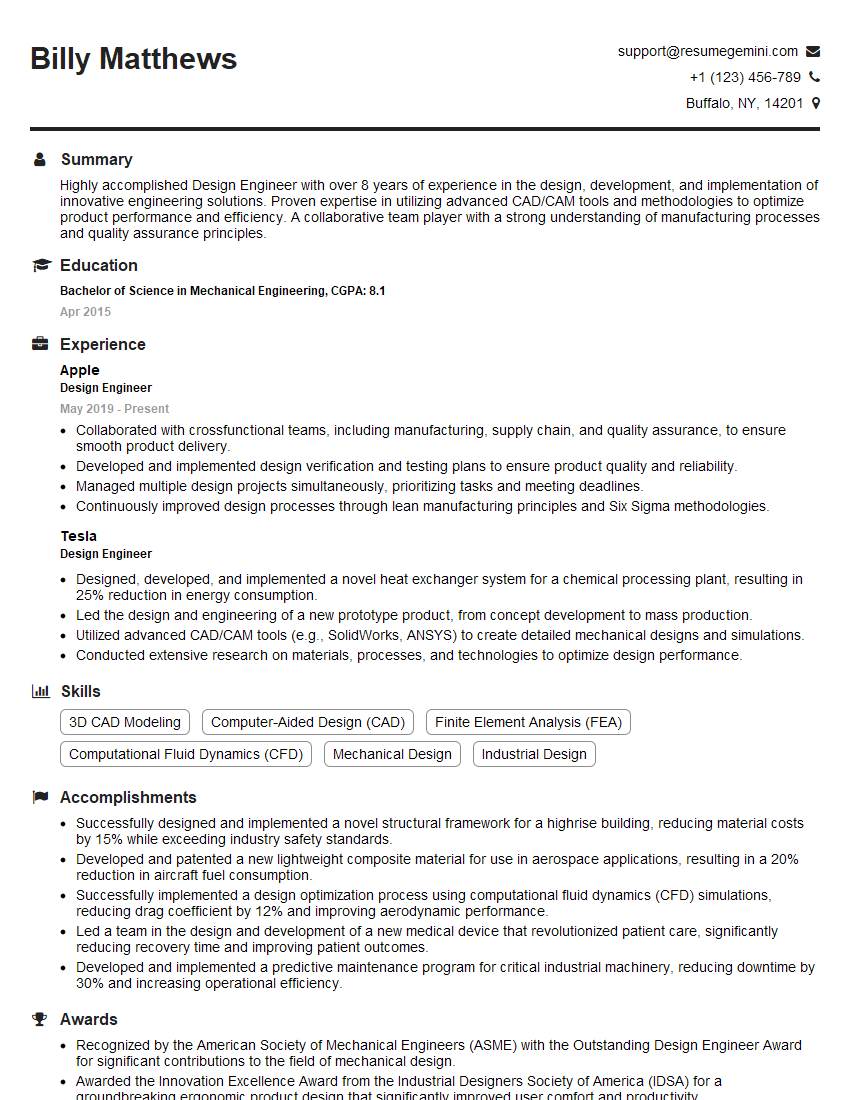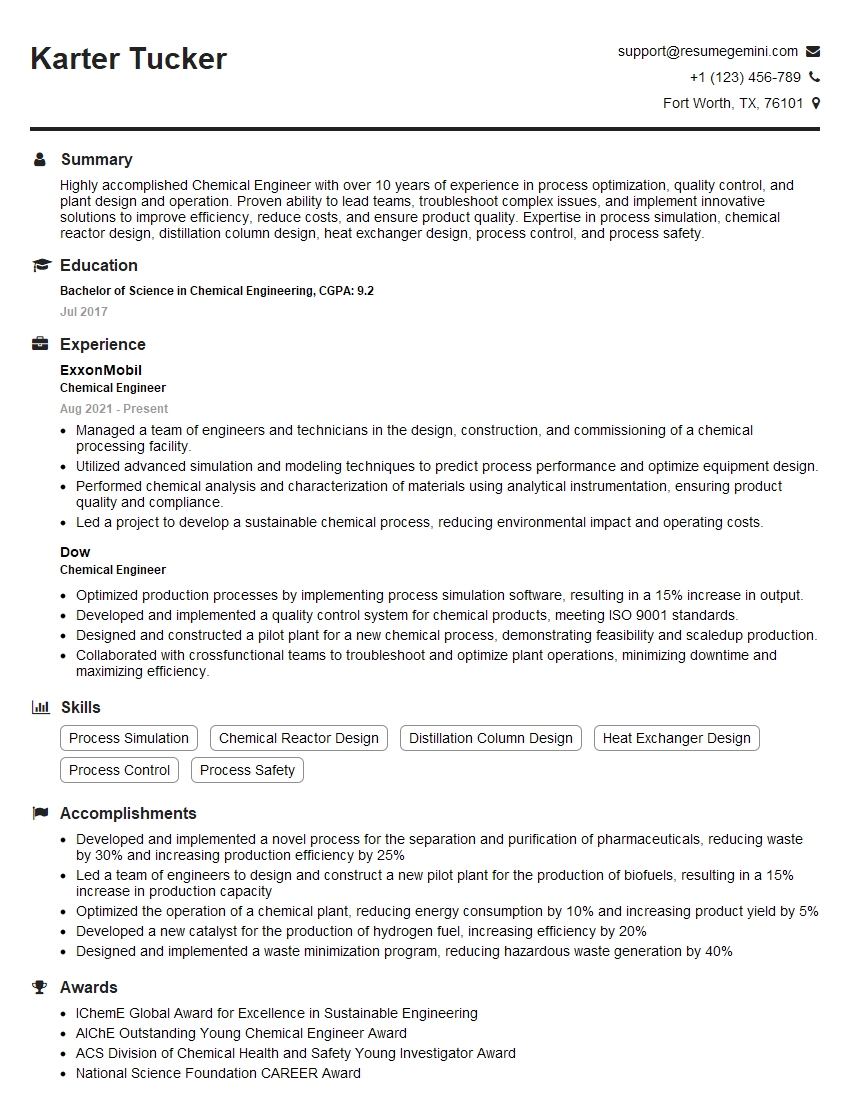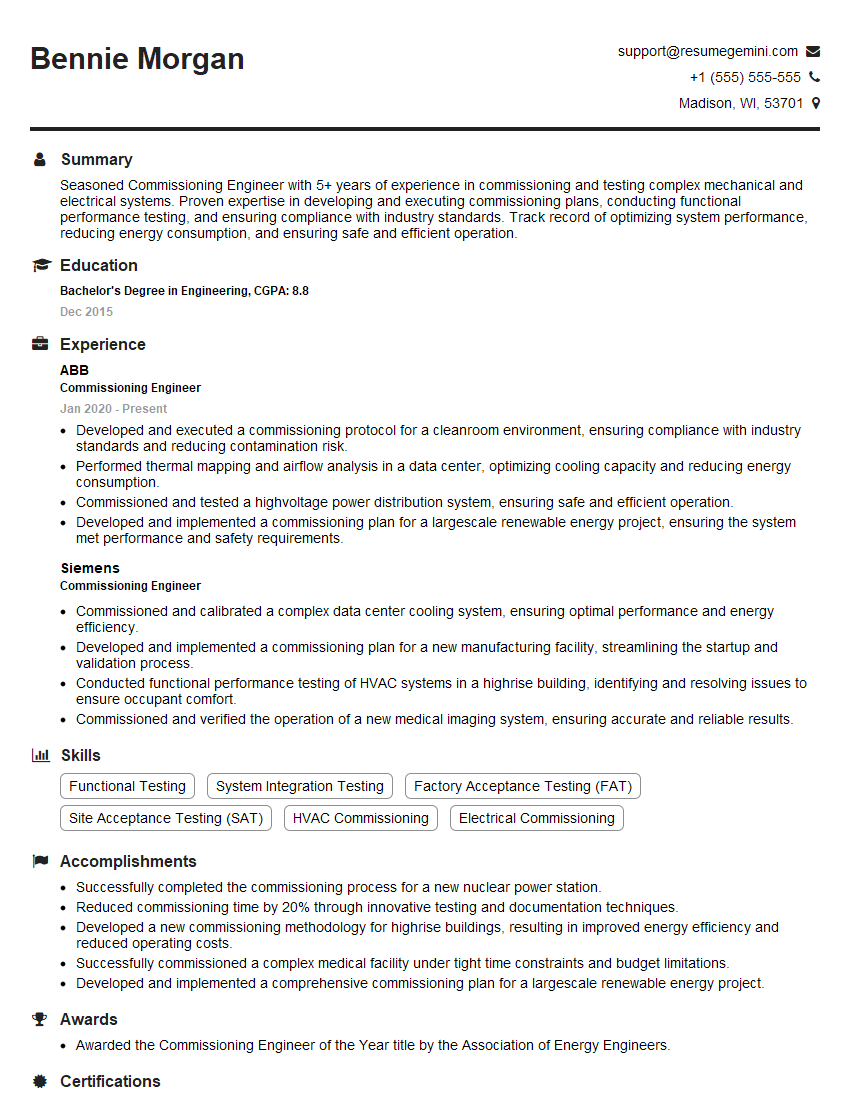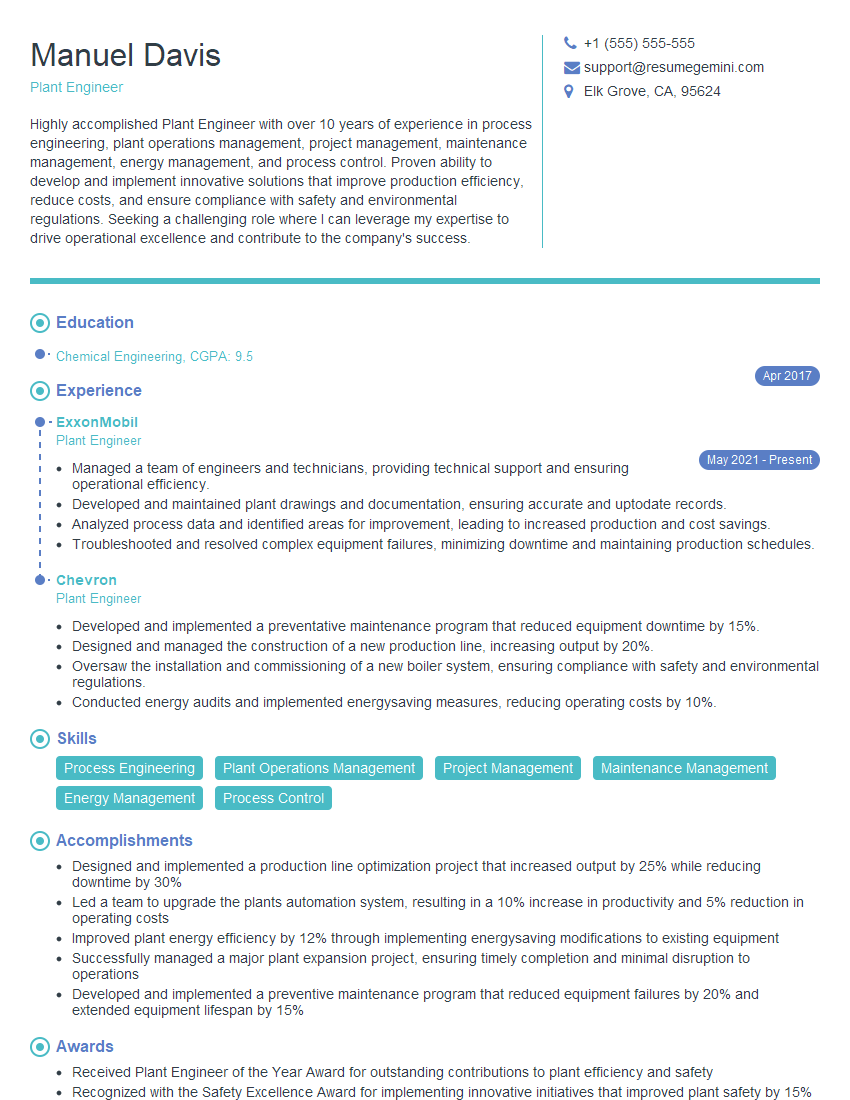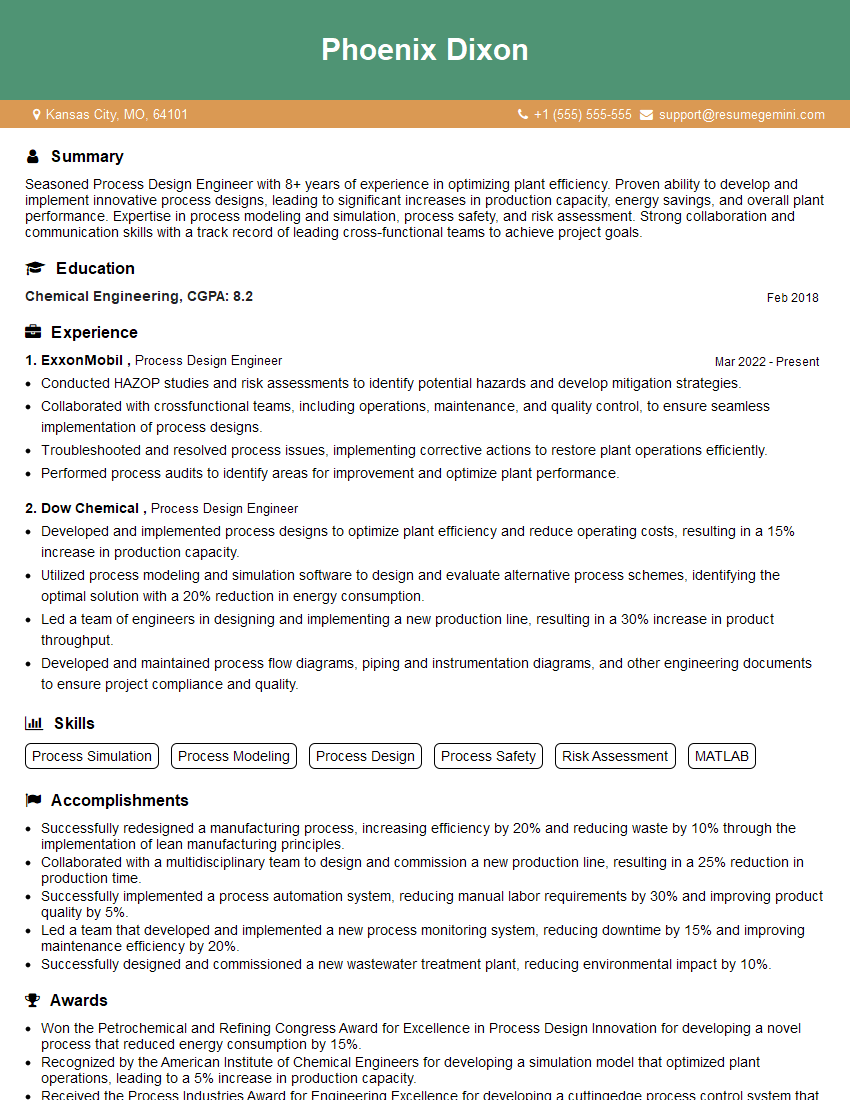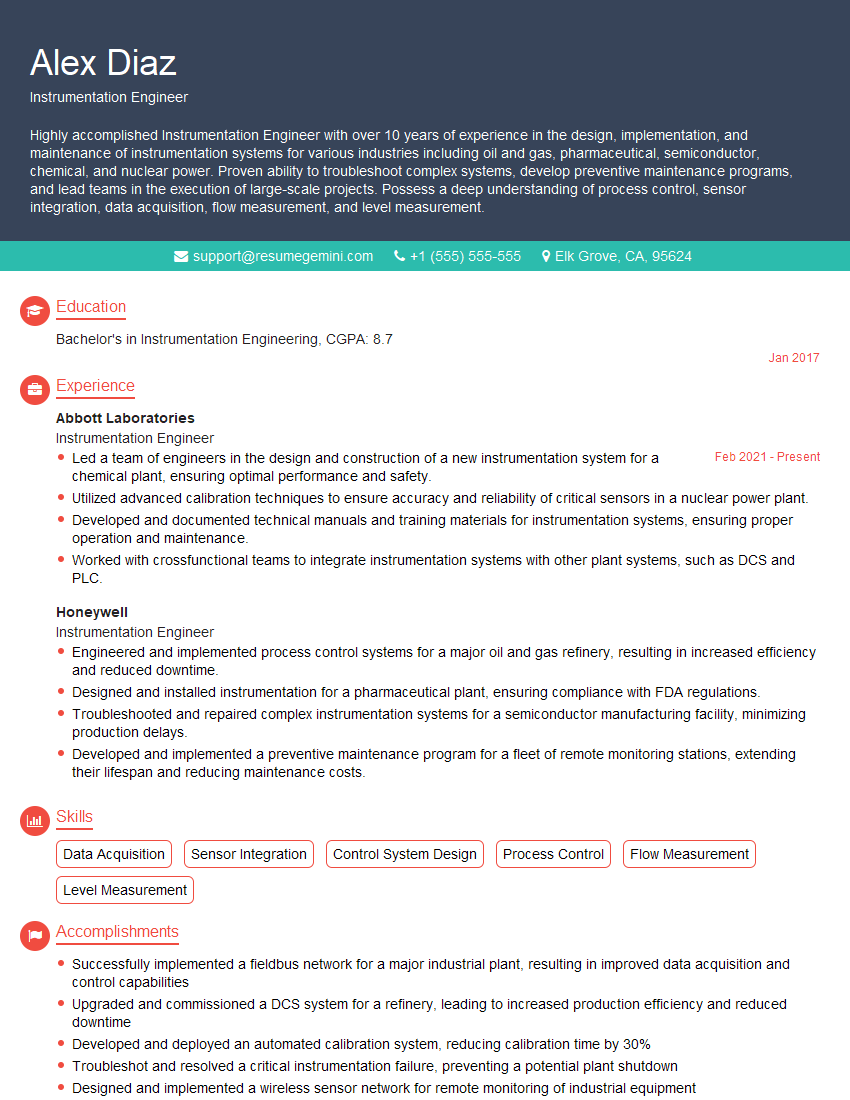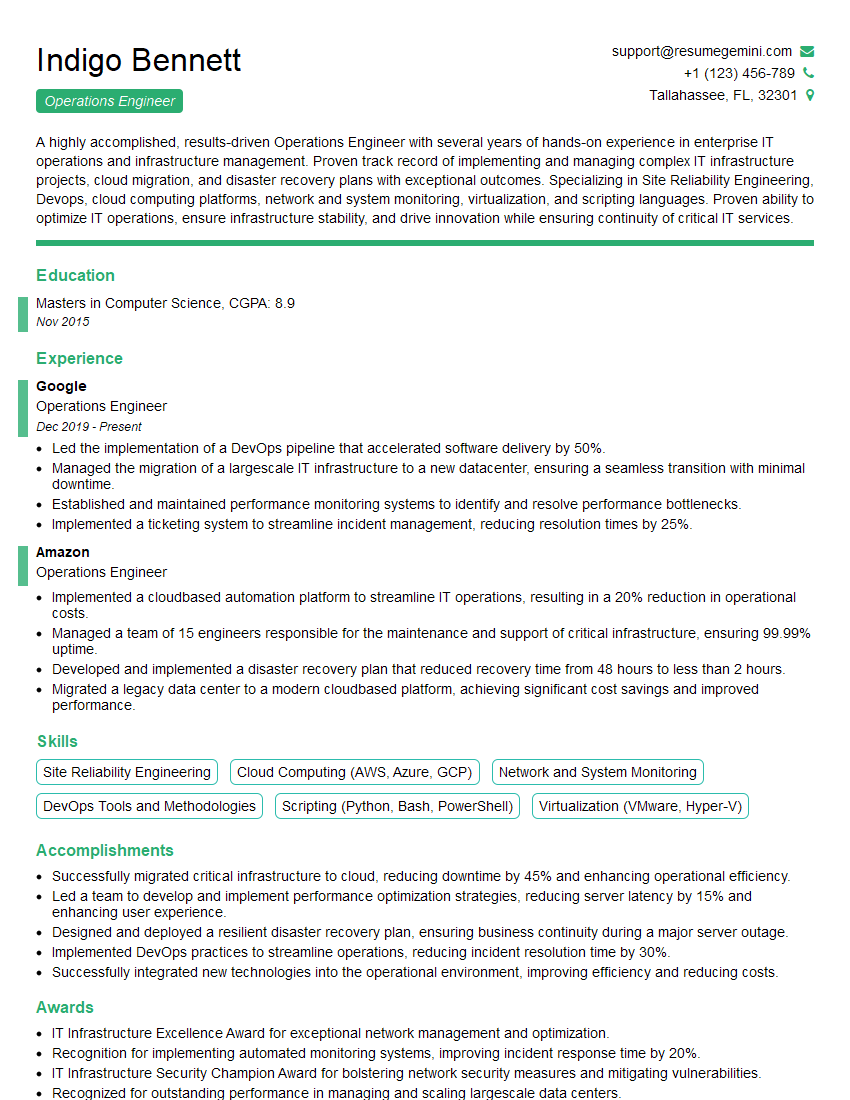The right preparation can turn an interview into an opportunity to showcase your expertise. This guide to Process Flowsheeting interview questions is your ultimate resource, providing key insights and tips to help you ace your responses and stand out as a top candidate.
Questions Asked in Process Flowsheeting Interview
Q 1. Explain the purpose of a process flowsheet.
A process flowsheet is a graphical representation of a chemical or industrial process. Think of it as a blueprint for a factory, showing the flow of materials and energy through various unit operations. It’s a crucial tool for process design, optimization, and troubleshooting. It provides a visual overview, making complex processes easier to understand and communicate. A well-designed flowsheet shows the sequence of operations, equipment involved, and the streams connecting them, including the materials’ composition and flow rates. This allows engineers to quickly identify potential bottlenecks, hazards, or inefficiencies.
For example, a flowsheet for a refinery might show crude oil entering, followed by various distillation columns, reactors, and separation units, ultimately producing gasoline, diesel, and other products. Each unit operation is represented by a specific symbol, and the streams connecting them are labeled with relevant information like temperature, pressure, and composition.
Q 2. What software packages are you proficient in for process flowsheeting?
I’m proficient in several industry-standard process flowsheeting software packages. My expertise includes Aspen Plus, HYSYS, and Pro/II. I’ve also worked with less common, but equally powerful, tools like gPROMS and ChemCAD, depending on the specific project requirements. My experience spans both steady-state and dynamic simulation capabilities within these platforms. I’m comfortable using these tools for a wide range of tasks, from basic material balance calculations to complex thermodynamic modeling and optimization studies.
Q 3. Describe your experience with P&ID development.
My P&ID (Piping and Instrumentation Diagram) development experience is extensive. I’ve been involved in the creation of P&IDs for various industrial processes, including refineries, chemical plants, and pharmaceutical facilities. I’m familiar with industry standards like ISA (Instrument Society of America) symbols and conventions. My experience extends beyond simply creating the diagrams; I ensure the P&IDs accurately reflect the process flowsheet, incorporating all equipment, instrumentation, piping, and control systems. I’ve also worked on integrating P&IDs with 3D modeling software for detailed plant design. For example, on a recent project, I developed P&IDs for a new chemical reactor system, carefully coordinating with the process engineers to ensure the design was both efficient and safe.
Q 4. How do you handle inconsistencies or errors in process data?
Inconsistencies and errors in process data are a common challenge in flowsheeting. My approach involves a systematic investigation. First, I meticulously review the source of the data, looking for potential errors in measurement, transcription, or data entry. Next, I perform thorough cross-checking within the flowsheet itself, ensuring mass and energy balances are consistent across all units. Discrepancies often point to specific areas needing further investigation. If the inconsistencies persist, I may employ sensitivity analysis to identify critical parameters contributing to the errors. I also utilize error propagation analysis to quantify the uncertainties associated with the data. Ultimately, the resolution involves careful evaluation of all available data, and sometimes requires additional experimental verification or refinement of the process model.
For instance, if a mass balance doesn’t close, I’d systematically check each stream’s flow rate and composition, potentially reviewing lab data or revisiting the assumptions made in the model. This iterative process ensures data integrity and model accuracy.
Q 5. Explain the concept of mass and energy balances in process flowsheeting.
Mass and energy balances are fundamental to process flowsheeting. A mass balance ensures that the mass entering a process unit equals the mass leaving, accounting for any accumulation or losses. Similarly, an energy balance ensures that the energy entering a process unit (e.g., heat input, work done) equals the energy leaving (e.g., heat output, work done), plus any changes in stored energy. These balances are crucial for verifying the consistency and feasibility of a process design. They’re based on the fundamental laws of conservation of mass and energy.
Imagine a simple distillation column. The mass balance would state that the mass of feed entering equals the sum of the mass of distillate and bottoms product leaving. The energy balance would account for the heat input required for vaporization and the heat removed in the condenser, ensuring energy conservation throughout the process. Violations of these balances indicate errors in the process design or input data.
Q 6. How do you validate a process flowsheet model?
Validating a process flowsheet model is critical to ensure its accuracy and reliability. This typically involves a multi-step approach. First, we verify the model’s consistency by checking for mass and energy balances. Then, we compare the model’s predictions with available experimental data or data from existing plants. If historical data exists, we calibrate the model to match those results. Sensitivity analysis helps determine how changes in input parameters affect the model’s output, assessing the model’s robustness. Finally, we might perform uncertainty analysis to quantify the impact of data uncertainty on the model’s predictions. This rigorous validation ensures the flowsheet provides a reliable representation of the real-world process.
Q 7. Describe your experience with process simulation software (e.g., Aspen Plus, HYSYS).
My experience with process simulation software, particularly Aspen Plus and HYSYS, is extensive. I’ve used both for steady-state and dynamic simulations of various processes, including distillation, reaction, and heat transfer operations. I’m skilled in developing and refining models, using appropriate thermodynamic models and property packages to accurately represent the process behavior. My experience extends to model calibration using experimental data, sensitivity analysis, and optimization studies to improve process efficiency. For example, I recently used Aspen Plus to optimize the operating conditions of a complex distillation column, resulting in a significant improvement in product purity and energy efficiency. I understand the limitations of each software and know when to leverage the strengths of each for a specific application.
Q 8. How do you incorporate safety considerations into your process flowsheet designs?
Safety is paramount in process flowsheeting. It’s not just an afterthought; it’s woven into every stage, from initial conceptual design to final validation. We incorporate safety considerations by employing several key strategies:
- Hazard Identification and Risk Assessment (HIRA): This is the foundational step. We use techniques like HAZOP (Hazard and Operability Study) and What-If analysis to systematically identify potential hazards, evaluate their likelihood and consequences, and determine the necessary safeguards. For example, in designing a reactor system, we’d consider runaway reactions, potential for over-pressurization, and flammability of the reactants.
- Inherent Safety Design Principles: We strive to design inherently safer processes. This means minimizing hazardous materials, using less hazardous substitutes, reducing the amount of material in the process, and simplifying the process design. For instance, using lower-pressure operations or reducing the batch size minimizes the consequences of potential failures.
- Safety Systems Integration: The flowsheet incorporates safety instrumented systems (SIS) such as emergency shutdown systems (ESD), pressure relief valves, and fire and gas detection systems. We model their behavior and ensure they are adequately sized and designed to mitigate identified hazards. For example, we’d model the response time of an ESD system to a high-pressure alarm in a reactor.
- Process Simulation for Safety Analysis: We use process simulators to model scenarios like equipment failures or upsets to assess the impact on safety and the effectiveness of safety systems. This allows us to identify potential vulnerabilities and design robust mitigation strategies. This could involve simulating a loss of cooling scenario in an exothermic reactor and checking if the safety systems prevent a runaway reaction.
Essentially, safety is not just a checklist; it’s a continuous process integrated into the entire flowsheet development lifecycle.
Q 9. Explain your experience with process optimization techniques.
My experience with process optimization is extensive. I’ve used a range of techniques, both on steady-state and dynamic models, to improve efficiency, reduce costs, and enhance product quality. These include:
- Pinch Analysis: For energy integration, I utilize pinch analysis to identify the minimum energy consumption and design efficient heat exchanger networks. This involves analyzing the temperature profiles of hot and cold streams to minimize energy utilities.
- Linear Programming (LP) and Nonlinear Programming (NLP): For optimizing operating parameters, I leverage LP and NLP techniques to find the optimal settings that maximize profit or minimize cost while satisfying process constraints. For example, optimizing the operating temperature and pressure of a distillation column to maximize product purity and minimize energy consumption.
- Simulation-Based Optimization: I frequently use process simulators coupled with optimization algorithms (like genetic algorithms or gradient-based methods) to fine-tune operating parameters and improve overall process performance. This involves iteratively running simulations and updating parameters based on the optimization algorithm’s guidance.
- Data-Driven Optimization: Using process data analysis and machine learning techniques, we can build predictive models and optimize processes in real-time. This can lead to improved control and better responsiveness to changing conditions.
In one project involving a chemical plant, I used a combination of pinch analysis and NLP to optimize the heat integration network and reduce energy consumption by 15%, resulting in significant cost savings.
Q 10. How do you handle uncertainty and sensitivity analysis in your flowsheet models?
Uncertainty is inherent in process modeling. To account for this, we employ robust techniques for uncertainty and sensitivity analysis:
- Monte Carlo Simulation: We use Monte Carlo methods to propagate uncertainties in input parameters (like feed composition, reaction kinetics, or equipment properties) through the model, resulting in a distribution of output results. This allows us to estimate the probability of exceeding critical limits or achieving desired performance targets.
- Sensitivity Analysis: This involves systematically varying input parameters to determine their influence on key outputs. Techniques include local sensitivity analysis (e.g., using partial derivatives) and global sensitivity analysis (e.g., variance-based methods). This helps identify the most influential parameters and prioritize data collection or model refinement efforts.
- Interval Analysis: This approach uses interval arithmetic to propagate uncertainty bounds throughout the model, providing an estimate of the range of possible outcomes without the computational intensity of Monte Carlo simulations.
For example, in modeling a distillation column, we’d incorporate uncertainty in the vapor-liquid equilibrium data and the column efficiency. The uncertainty and sensitivity analysis would then help to quantify the impact of these uncertainties on the product purity and energy consumption.
Q 11. Describe your experience with different unit operation models.
My experience encompasses a wide range of unit operation models, including:
- Reactors: I’m proficient in modeling various reactor types, including CSTRs (Continuous Stirred Tank Reactors), PFRs (Plug Flow Reactors), and batch reactors, using both empirical correlations and rigorous kinetic models. This includes accounting for heat transfer, mass transfer, and reaction kinetics.
- Distillation Columns: I’ve extensively worked with different distillation models, from simple equilibrium stage models to rigorous models incorporating tray efficiency, pressure drop, and liquid holdup.
- Heat Exchangers: My expertise includes modeling various heat exchanger types, such as shell-and-tube, plate, and double-pipe exchangers, using both empirical correlations and more detailed computational fluid dynamics (CFD) models when necessary.
- Compressors and Pumps: I’m experienced in using both simple empirical correlations and more detailed thermodynamic models to simulate compressor and pump performance, including efficiency curves and pressure drop calculations.
- Fluid Flow and Piping Systems: I’m familiar with modeling fluid flow in pipes and equipment using equations like the Darcy-Weisbach equation, accounting for frictional losses and other pressure drops.
The choice of model depends on the desired level of accuracy, available data, and computational resources. For preliminary design, simpler models may suffice, while for detailed design and optimization, more rigorous models are often necessary.
Q 12. How do you select appropriate thermodynamic models for your simulations?
Selecting the appropriate thermodynamic model is critical for accurate process simulation. The choice depends on the specific system, the desired accuracy, and the available data. Key factors to consider include:
- Fluid Properties: For simple systems with well-defined properties, equations of state like Peng-Robinson or Soave-Redlich-Kwong may be sufficient. For more complex systems with non-ideal behavior, activity coefficient models (e.g., NRTL, UNIQUAC) or more advanced equations of state (e.g., PC-SAFT) may be necessary.
- Temperature and Pressure Range: The model’s validity is limited by the temperature and pressure range. It’s crucial to ensure that the selected model is appropriate for the operating conditions.
- Composition: For mixtures of different components, the model should accurately represent the interactions between components. The choice of mixing rules also plays a significant role.
- Computational Cost: More complex models require more computational resources. It’s important to balance accuracy with computational efficiency.
For example, in simulating a cryogenic air separation unit, where components are at very low temperatures, an equation of state that accurately predicts properties at cryogenic conditions is essential. I typically start with a simpler model and then progressively refine the model based on the results and the level of accuracy required.
Q 13. What are the key differences between steady-state and dynamic simulations?
Steady-state and dynamic simulations differ fundamentally in their approach to time:
- Steady-State Simulation: Assumes that the process variables (temperature, pressure, flow rates, compositions) do not change with time. It provides a snapshot of the process at a specific operating condition. Steady-state simulations are computationally less demanding and are often used for initial design, sizing equipment, and evaluating steady-state performance.
- Dynamic Simulation: Considers the time-dependent behavior of the process. It accounts for changes in process variables over time, providing a more realistic representation of how the process responds to disturbances or changes in operating conditions. Dynamic simulations are computationally more expensive but essential for studying process control, transient events (e.g., startups, shutdowns, upsets), and safety analysis.
Think of it like taking a photograph (steady-state) versus making a video (dynamic). The photograph shows a single moment in time, while the video shows how things change over time. Dynamic simulations are crucial for designing and analyzing control systems and for understanding the process response to disturbances.
Q 14. How do you troubleshoot and debug a process flowsheet model?
Troubleshooting a process flowsheet model involves a systematic approach:
- Verify Input Data: The first step is to carefully check the input data, including stream properties, equipment parameters, and reaction kinetics. Errors in input data are a common source of problems.
- Examine the Model Structure: Check the model’s structure for inconsistencies, such as incorrect connections between units or improper specification of unit operation parameters.
- Check Unit Operation Models: Ensure that the chosen unit operation models are appropriate and properly configured for the given application.
- Perform Convergence Analysis: If the simulation is not converging, examine the convergence parameters and adjust them as needed. This may involve changing the solver settings or tightening the convergence tolerances.
- Simplify the Model: In complex models, simplifying the model by removing less critical elements can help identify the source of the problem.
- Check Mass and Energy Balances: Verify that the mass and energy balances are satisfied throughout the process. Significant deviations indicate errors in the model.
- Review Simulation Output: Carefully examine the simulation output for any unrealistic or unexpected results, which may pinpoint the location of the error.
Often, I use a combination of these techniques, working iteratively to identify and resolve the errors. Debugging often involves close examination of mass and energy balances around suspect units, as inconsistencies there usually point to the issue.
Q 15. Explain your understanding of process control and instrumentation.
Process control and instrumentation are the heart of any successful chemical process. Process control ensures that a process operates safely and efficiently, maintaining desired product quality and maximizing throughput. This is achieved by measuring key process variables (like temperature, pressure, flow rate, and composition) using instruments like thermocouples, pressure transmitters, and flow meters. This data is then fed to a control system (often a Distributed Control System or DCS) which manipulates control elements (like valves and pumps) to maintain the process at the setpoint.
For example, in a distillation column, temperature sensors measure the temperature at various trays. If the temperature deviates from the setpoint, the control system adjusts the reflux flow rate (using a control valve) to bring it back to the desired operating condition. Instrumentation ensures accurate measurement of these variables, forming the basis for effective control. A malfunctioning temperature sensor could lead to off-spec product or even a safety hazard.
My experience encompasses working with various control strategies, including PID control (Proportional-Integral-Derivative), cascade control, and advanced process control (APC) techniques like model predictive control (MPC). I’m proficient in selecting and sizing appropriate instrumentation and control valves, ensuring their proper integration with the process.
Career Expert Tips:
- Ace those interviews! Prepare effectively by reviewing the Top 50 Most Common Interview Questions on ResumeGemini.
- Navigate your job search with confidence! Explore a wide range of Career Tips on ResumeGemini. Learn about common challenges and recommendations to overcome them.
- Craft the perfect resume! Master the Art of Resume Writing with ResumeGemini’s guide. Showcase your unique qualifications and achievements effectively.
- Don’t miss out on holiday savings! Build your dream resume with ResumeGemini’s ATS optimized templates.
Q 16. Describe your experience with process integration techniques.
Process integration focuses on optimizing the overall process efficiency by identifying and exploiting synergies between different process units. This leads to significant cost savings, reduced energy consumption, and minimized environmental impact. I have extensive experience applying Pinch Analysis for heat integration, which helps to minimize the utility requirements (heating and cooling) of a process by matching hot and cold process streams.
For instance, I worked on a project where Pinch Analysis identified opportunities to use the waste heat from an exothermic reactor to preheat the feed streams to another unit, reducing the overall energy consumption by 15%. Beyond heat integration, I’ve also applied process integration techniques like mass integration and water integration, aiming to optimize the use of resources and reduce waste generation. This includes exploring options for recycle streams and implementing process intensification techniques to minimize equipment size and capital costs. My experience spans various industries, including refining, petrochemicals, and pharmaceuticals, showcasing adaptability to diverse process types.
Q 17. How do you communicate technical information effectively to both technical and non-technical audiences?
Effective communication is crucial in process engineering. I tailor my communication style to the audience. For technical audiences, I use precise terminology, detailed diagrams (like P&IDs – Piping and Instrumentation Diagrams), and data-driven presentations. For non-technical audiences, I use analogies, simplified language, and focus on the big-picture impacts (like cost savings or environmental benefits).
For example, when explaining a complex control strategy to a management team, I avoid intricate control algorithms and focus on how it will improve plant efficiency and reduce downtime. I frequently use visual aids like flowcharts and bar charts to convey complex information concisely. I believe active listening and ensuring the audience understands the core message are paramount. My experience in presenting technical reports, leading project meetings, and training junior engineers has honed these communication skills.
Q 18. Explain your experience with process safety analysis (e.g., HAZOP, What-if analysis).
Process safety analysis is critical for preventing accidents. I have extensive experience conducting HAZOP (Hazard and Operability) studies and What-if analyses. A HAZOP study systematically examines the process flowsheet, identifying potential deviations from normal operation and assessing their consequences. What-if analysis involves brainstorming potential scenarios and evaluating their risks. These analyses use a structured approach, involving a multidisciplinary team to cover all perspectives.
In a recent project, a HAZOP study identified a potential runaway reaction scenario in a reactor. This led to the implementation of a safety relief system (including a rupture disk and flare system) and improved process control strategies to mitigate the risk. I am proficient in documenting these analyses and preparing safety reports, ensuring compliance with safety standards and regulations.
Q 19. How do you handle deviations from design specifications during project execution?
Deviations from design specifications are inevitable during project execution. My approach involves a structured problem-solving methodology. First, I meticulously document the deviation, including its cause, impact, and potential consequences. Then, I work with the project team to evaluate various options for addressing the deviation. This includes assessing the technical feasibility, cost implications, and safety aspects of each option.
The chosen solution is documented and approved through the appropriate change management processes. I also ensure thorough communication to all stakeholders, keeping them informed of the deviation, the proposed solution, and its impact on the project timeline and budget. A crucial aspect is learning from deviations, documenting lessons learned for future projects, and continuously improving project execution procedures.
Q 20. Describe your experience with process scale-up and scale-down.
Process scale-up and scale-down involve adjusting process parameters and equipment sizes to change the production capacity. Scale-up is increasing the production scale, while scale-down is reducing it (e.g., for laboratory experiments). It’s not simply a matter of multiplying parameters; it involves understanding the underlying process phenomena and ensuring that the scaled process behaves as expected.
I’ve been involved in projects scaling up fermentation processes for pharmaceuticals. Here, factors like mass transfer and heat transfer become critical as the scale changes. We employed computational fluid dynamics (CFD) simulations to model the scaled-up process and predict its performance, minimizing the risk of scaling issues. For scale-down, I’ve used similar modeling techniques to design laboratory experiments that accurately reflect the behavior of the large-scale process, enabling efficient process optimization before full-scale implementation. This approach minimizes the risk and cost associated with scaling challenges.
Q 21. What are the limitations of process flowsheeting software?
While process flowsheeting software is an invaluable tool, it has limitations. One key limitation is the reliance on simplified models. Real-world processes are complex, and software often uses simplified equations and assumptions that might not capture all the subtleties of the process behavior. This can lead to inaccuracies in predictions, especially for complex multiphase systems or non-ideal behavior.
Another limitation is the potential for human error in data entry and model building. Incorrectly defined parameters or flawed modeling choices can lead to erroneous results. Finally, the software’s capabilities are limited by its features. Advanced process simulations might require specialized software or expertise beyond the capabilities of standard flowsheeting packages. It’s crucial to be aware of these limitations and to use the software responsibly, validating results with experimental data or more sophisticated modeling techniques where necessary.
Q 22. How do you ensure the accuracy and reliability of your process flowsheet models?
Ensuring the accuracy and reliability of process flowsheet models is paramount. It’s like building a house – a shaky foundation leads to a collapsing structure. We achieve this through a multi-pronged approach:
Rigorous Data Validation: Before even starting the model, we meticulously verify all input data, including thermodynamic properties, kinetic parameters, and equipment specifications. Inconsistencies or errors at this stage can propagate throughout the entire simulation.
Modular Modeling: We break down complex processes into smaller, manageable modules. This allows for easier debugging, verification, and modification of individual units. Think of it like assembling a car – you wouldn’t build the entire thing at once.
Model Verification and Validation: We compare our model predictions against experimental data or established correlations wherever possible. This iterative process helps refine the model and identify areas needing improvement. For instance, comparing simulated yields to those from pilot plant tests.
Sensitivity Analysis: We systematically vary key input parameters to assess their impact on the model’s output. This helps us identify critical variables and quantify uncertainties. A sensitivity analysis might show that the reactor temperature is far more critical to the outcome than the feed flow rate.
Proper Choice of Thermodynamic Models: Selecting the correct thermodynamic property package (like Peng-Robinson or Soave-Redlich-Kwong) is crucial, especially for complex mixtures or systems operating under extreme conditions. The wrong choice can lead to significant errors in phase equilibrium calculations.
Documentation and Version Control: Maintaining detailed documentation and using version control systems (like Git) are critical for transparency and traceability. This ensures that all model changes are tracked and easily reviewed.
Q 23. Describe your experience with different types of reactors and their modeling.
My experience encompasses a wide range of reactor types, including CSTRs (Continuous Stirred Tank Reactors), PFRs (Plug Flow Reactors), and various specialized reactors like fluidized beds and membrane reactors. Each reactor type presents unique modeling challenges:
CSTRs: Relatively simple to model, assuming perfect mixing. The design equations are algebraic and easy to solve. However, real CSTRs often deviate from perfect mixing, requiring more sophisticated models.
PFRs: Require solving differential equations, which account for changes in concentration and temperature along the reactor length. Numerical methods, such as finite difference or finite element methods are often employed. This is more complex than CSTR modelling.
Fluidized Beds: These are complex systems requiring models that account for fluid mechanics, heat transfer, and particle dynamics. Computational Fluid Dynamics (CFD) is often employed for detailed simulations.
Membrane Reactors: Models must consider mass transfer across the membrane, reaction kinetics, and membrane fouling. These are highly specialized models.
I’m proficient in using commercial simulators like Aspen Plus and HYSYS, which provide comprehensive reactor models and allow for the incorporation of user-defined kinetics. For instance, I’ve successfully modeled a gas-phase reaction in a PFR using a detailed kinetic model, accurately predicting product yields and temperature profiles.
Q 24. How do you use process flowsheeting to evaluate different design options?
Process flowsheeting is invaluable for evaluating design options. Instead of building multiple prototypes, we can virtually test different configurations and operating parameters. This saves time, resources, and reduces risks. For example:
Reactor Configuration: We can compare the performance of a CSTR versus a PFR for a given reaction, considering factors like conversion, selectivity, and reactor size.
Separation Processes: We can evaluate the effectiveness of different separation techniques (distillation, extraction, etc.), optimizing for energy consumption and purity.
Heat Integration: Process flowsheeting tools enable the design of efficient heat exchangers networks, minimizing energy costs and environmental impact. This can lead to significant savings.
Process Control Strategies: We can simulate the response of the process to different control schemes, ensuring stability and optimal operation.
By systematically varying design parameters and analyzing the results, we can identify the optimal design that meets the project objectives, often with better results than relying only on intuition or experience.
Q 25. Explain your experience with economic analysis of process designs.
Economic analysis is an integral part of process design. A technically sound process is worthless if it’s not economically viable. My experience includes performing detailed cost estimations using tools like Aspen Icarus and conducting Discounted Cash Flow (DCF) analyses. This involves:
Capital Cost Estimation: Estimating costs for equipment (reactors, separators, pumps, etc.), utilities, and construction.
Operating Cost Estimation: Projecting costs for raw materials, utilities, labor, maintenance, and waste disposal.
Revenue Projections: Estimating revenue based on product sales.
Profitability Analysis: Evaluating the profitability of the project using metrics like Net Present Value (NPV), Internal Rate of Return (IRR), and Payback Period.
For instance, during a project involving the design of an ammonia synthesis plant, I performed a detailed economic analysis comparing different reactor configurations and operating pressures. This enabled the selection of the most cost-effective design, considering both capital and operating costs. The results were instrumental in the final investment decision.
Q 26. How do you stay updated on the latest advancements in process flowsheeting technology?
Staying updated is crucial in this rapidly evolving field. I actively engage in several strategies:
Industry Conferences and Workshops: Attending conferences like AIChE’s Annual Meeting allows me to learn about cutting-edge technologies and network with other professionals.
Professional Development Courses: I regularly participate in online and in-person training courses offered by software vendors and professional organizations to enhance my skills in specific areas.
Reading Technical Literature: I follow leading journals (e.g., Chemical Engineering Science, AIChE Journal) and industry publications to stay abreast of the latest research and developments.
Online Communities and Forums: Participating in online forums and communities allows me to exchange knowledge and discuss challenges with other professionals in the field.
Software Updates and Tutorials: I keep my process simulation software updated and regularly explore new features and functionalities through online tutorials and documentation.
Q 27. Describe your experience working with multidisciplinary teams on process projects.
Successful process projects are rarely completed in isolation. I have extensive experience collaborating with multidisciplinary teams, including chemical engineers, mechanical engineers, process control specialists, and economists. Effective teamwork is crucial, and I foster it by:
Clear Communication: Ensuring clear and concise communication of technical information and project updates, using a variety of tools such as shared documents, regular meetings, and presentations.
Active Listening: Paying attention to the perspectives and expertise of team members from different disciplines.
Conflict Resolution: Addressing disagreements and challenges constructively and professionally to ensure team cohesion and project progress.
Collaboration Tools: Effectively using project management software and shared document repositories to facilitate communication and collaboration.
For example, in a recent project involving the design of a new pharmaceutical plant, I actively collaborated with mechanical engineers to ensure the flowsheet was compatible with the chosen equipment, and with process control specialists to define the control strategy.
Q 28. How would you approach designing a flowsheet for a novel process?
Designing a flowsheet for a novel process requires a systematic and iterative approach:
Thorough Understanding of the Chemistry: First and foremost, a deep understanding of the reaction kinetics, thermodynamics, and potential side reactions is essential. This understanding will inform all aspects of the flowsheet.
Conceptual Design: This involves defining the overall process strategy, identifying key unit operations, and selecting suitable equipment. This might involve brainstorming, literature review, and preliminary calculations.
Flowsheet Development: Using process simulation software, a preliminary flowsheet is constructed, incorporating mass and energy balances, reaction kinetics, and equipment sizing. Initial iterations will often involve many modifications based on simulation outputs.
Process Optimization: Once a basic flowsheet is established, optimization strategies are employed to improve process efficiency and reduce costs. This could involve changes to reactor design, operating parameters, or heat integration schemes.
Process Verification: The model’s predictions must be verified using experimental data, either from laboratory-scale experiments or pilot plant trials. This step is crucial to ensure that the flowsheet accurately represents the actual process.
Detailed Engineering: Once the process is thoroughly verified, detailed engineering drawings and specifications are developed for all equipment and components.
Designing a flowsheet for a novel process is more challenging than working with established processes. It often demands creativity, innovative thinking, and careful evaluation of different design alternatives, often guided by experimental results at different stages.
Key Topics to Learn for Process Flowsheeting Interview
- Material and Energy Balances: Understanding and applying fundamental principles to process simulations; practical application in optimizing reactor yields or distillation column design.
- Process Simulation Software: Proficiency in at least one major software package (Aspen Plus, HYSYS, etc.); practical experience in building and troubleshooting process models, including steady-state and dynamic simulations.
- Thermodynamics and Phase Equilibria: Applying thermodynamic principles to process calculations; practical application in designing separation processes or predicting reaction equilibrium.
- Process Design and Optimization: Understanding process intensification techniques and optimization strategies; practical application in improving process efficiency and reducing costs.
- Unit Operations: In-depth knowledge of common unit operations (reactors, heat exchangers, distillation columns, etc.); practical experience in sizing and selecting appropriate equipment.
- Process Control and Instrumentation: Understanding basic control strategies and instrumentation; practical application in designing control loops for stable and efficient operation.
- Troubleshooting and Problem Solving: Ability to diagnose and resolve process flowsheeting issues; practical application in identifying bottlenecks and improving process performance.
- Process Safety: Understanding safety considerations in process design and operation; practical application in identifying and mitigating potential hazards.
Next Steps
Mastering process flowsheeting opens doors to exciting career opportunities in chemical engineering, process design, and related fields. A strong understanding of these principles is highly sought after by employers, leading to higher earning potential and faster career progression. To maximize your job prospects, creating an ATS-friendly resume is crucial. ResumeGemini is a trusted resource that can help you build a compelling and effective resume that gets noticed. We provide examples of resumes tailored to Process Flowsheeting to give you a head start. Invest time in crafting a strong resume – it’s your first impression on potential employers.
Explore more articles
Users Rating of Our Blogs
Share Your Experience
We value your feedback! Please rate our content and share your thoughts (optional).
What Readers Say About Our Blog
Interesting Article, I liked the depth of knowledge you’ve shared.
Helpful, thanks for sharing.
Hi, I represent a social media marketing agency and liked your blog
Hi, I represent an SEO company that specialises in getting you AI citations and higher rankings on Google. I’d like to offer you a 100% free SEO audit for your website. Would you be interested?


